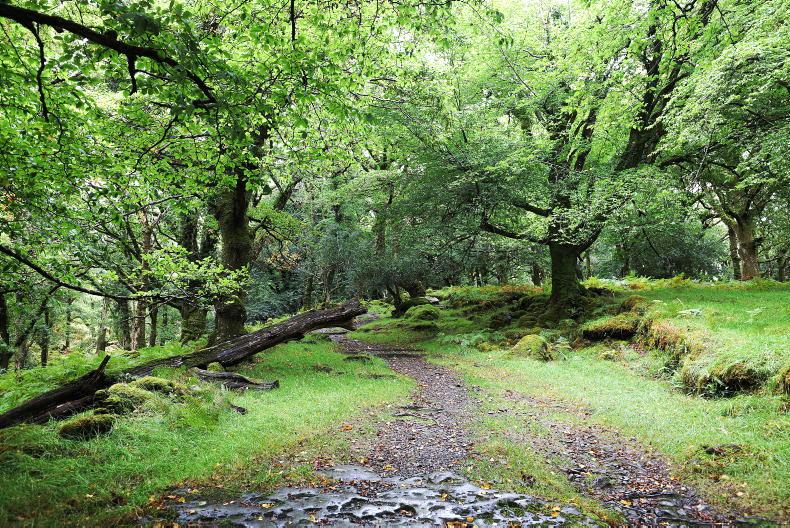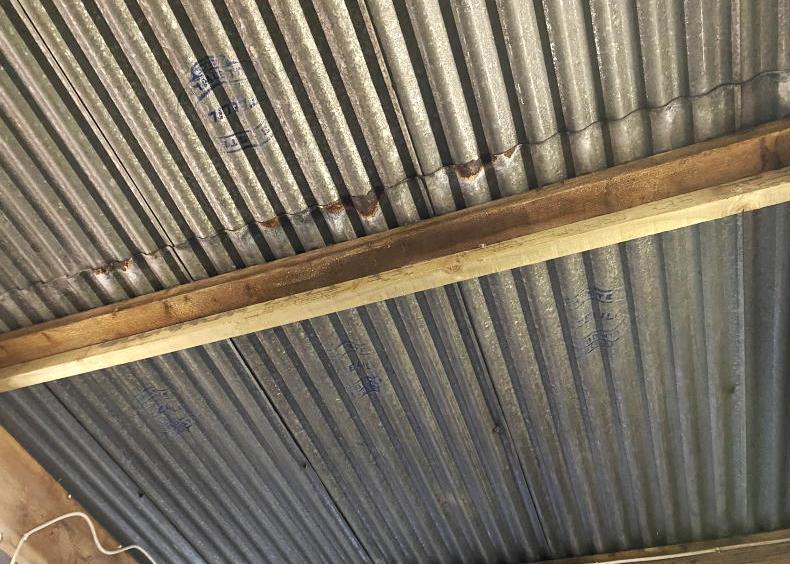The announcement by Minister for Agriculture Michael Creed that the fifth tranche of the Traditional Farm Buildings Grant Scheme is open for applications has generated a lot of queries from farmers. If you are serious about getting your project approved, you need to submit a well-drafted application.
Competition for a place in the scheme is fierce as always. More than 340 farmers applied in 2018, with 50 projects supported. In 2019, 279 applications were received and 76 projects were supported.
Farmers are not required to hire a conservation consultant at the application stage. You should, however, make contact with the consultant at this stage to secure their services, should your application be successful.

Michael’s shed before the renovation.
Application
Before filling out the application, you should familiarise yourself with the scheme’s objective: to ensure traditional farm buildings and other structures that contribute to the character of the landscape and are of significant heritage value are conserved for agricultural use.
It would also be worthwhile reading the terms and conditions of the scheme on the Heritage Council website.
This outlines the buildings covered – traditional farm buildings or structures constructed before 1960 that are in a fair condition. According to Anna Meenan from the Heritage Council there are a wide range of projects popping up in applications.
“Everything and anything. From a needle to haystack,” she said.
The application (which can be downloaded from the Heritage Council website) is not too taxing to fill out.
The questions should be answered carefully, demonstrating your interest in the project and your capacity to carry out the works. All eligible applications will be reviewed by a selection committee.
The highest-priority projects will be chosen in line with the available funding. Weighting may be applied to the criteria in order to promote applications with the highest biodiversity, landscape and environmental benefit.
Farmers filling out the form should pay particular attention to questions on the heritage of the structure, the public benefit including the landscape, habitat value or potential, and environmental sustainability.
The more information you can give on the heritage interest the better – whether the structure was architecturally designed, is it rare, has it a thatched roof, when was it built, what was it used for and is it part of a bigger picture?
Regarding the public benefit – will the project add to the landscape, have you hosted public events on your farm and would you be willing to host traditional skills events in the future?
In regards to the habitat value – is the building a home to wildlife and have you done anything to enhance the habitat value, like installing bird boxes, for example?
Costs/funding
The council looks for the estimated costs of the project at the application stage. Farmers can submit a cost for their own labour in this section, if they are doing some or all of the work themselves.
If hiring in labour, a builder’s quotation is needed. A grant award will not be provided for more than 75% of the cost of the works with a maximum of €25,000 (min €4,000).
Photos
Photos are key to your application. They are crucial for winning over the people studying your proposal. The following will need to be submitted:
Clear photographs of the exterior of the building/other related structure.Clear photographs of it in its wider surroundings in the countryside.Clear photographs of any parts in need of repair.Clear photographs of the interior (required where building is applied for).What next
After submitting a hard copy of your application to the Heritage Council by the deadline of 18 February 2020, you should receive an acknowledgement letter shortly after. In April 2020 grant offers will be issued.
Farmer experience
Part-time farmer Micheal Millerick carried out repairs on the almost 200-year old sheds on his farm in Ballymacoda, in east Cork through the GLAS Traditional Farm Building Grant last year. Michael said he originally believed that his farm buildings would not be suitable for the scheme.
“I used to think that just big cut stone buildings on old landlord estates were covered in such schemes, not more modest buildings like the ones on my farm,” Michael explained. However, during a heritage open day Michael got talking to Chris Southgate, a conservation consultant based in Cork and his opinion changed. Chris looked at some photos of Michael’s building and said it would be ideal for the scheme.
One unique feature in this building is the presence of a bench mark, which was part of the ordnance survey of Ireland used to map the country in the 1830s. The bench mark used to determine the height above sea level at a given location and in the past was a protected structure.
Michael says originally his outbuildings were thatched, but this was replaced with galvanised sheets approximately 70 years ago. The walls were constructed of stone and lime mortar and they were used for general farming purposes. In recent years, the roof had been showing its age and some of the galvanised sheets were rusting and falling in. Michael said it was coming to the point that if remedial work was not carried out, the building was going to fall into disrepair.
When the 2019 scheme opened this time last year Michael prepared and submitted an application to the Heritage Council. This was after meeting with his conservation consultant. In the application, he had to include the repairs required, the estimated costs of the work, the heritage interest and environmental/wildlife considerations etc.
Michael’s building was shortlisted by the Heritage Council in March 2019. He attended a seminar in Athlone at that time, to listen to past applicants experiences and hear from conservation experts about old farm building repair work. A more detailed plan and costings (conservation specification) were submitted in March by his consultant to the heritage council.
On 13 May 2019, Michael received a grant offer. A preliminary inspection was then carried out by the council on the building. The conservation consultant and the builder, Pat Shanahan, also had an on-site meeting to ensure the work was carried out to the specifications agreed. Michael had to organise a bird and bat survey to ensure wildlife were not nesting or roosting in the building. Fortunately, the building was clear and work started in July 2019.
Approximately 70% of the timbers in the roof were re-used in the building. Some sections of timber had to be cut where rot had set in, but a new piece was spliced into the existing one.
Similarly, if it was possible to re-use the galvanised sheeting, it was reused. During building work, Chris the consultant submitted an interim report to the council, to inform them of the progress made.
Where timbers in the roof had to be replaced, larch was used to ensure the longevity of the building. Heavy 0.65mm galvanise was also used for the replacement sheets. Approximately 20% of the original galvanised sheets were recycled. The building also got a fresh coat of white wash.
When the work was complete a final report and documentation was submitted to the Heritage Council. On 13 September the repaired building was inspected by the Council and payment was issued shortly after.
The project cost just over €15,330 and 75% of this cost was covered by the heritage grant, which meant Michael received €11,500. Sharon O’Mahoney and Eimear Connery from the Teagasc Midleton office organised a public open day in October 2019 for future applicants to see Michael’s shed and over 20 people attended.
“I was very lucky that I had no delays whatsoever, everything went to plan without a hitch,” Michael said. He was very happy with the work carried out and the whole process.
“I would encourage people to definitely apply, but make sure to bring in the conservation experts from the start to get their advice,” he said.
The building should now be preserved for another 30 to 40 years before it needs major work again and in the meantime, it will be useful storage area for the farm.
The announcement by Minister for Agriculture Michael Creed that the fifth tranche of the Traditional Farm Buildings Grant Scheme is open for applications has generated a lot of queries from farmers. If you are serious about getting your project approved, you need to submit a well-drafted application.
Competition for a place in the scheme is fierce as always. More than 340 farmers applied in 2018, with 50 projects supported. In 2019, 279 applications were received and 76 projects were supported.
Farmers are not required to hire a conservation consultant at the application stage. You should, however, make contact with the consultant at this stage to secure their services, should your application be successful.

Michael’s shed before the renovation.
Application
Before filling out the application, you should familiarise yourself with the scheme’s objective: to ensure traditional farm buildings and other structures that contribute to the character of the landscape and are of significant heritage value are conserved for agricultural use.
It would also be worthwhile reading the terms and conditions of the scheme on the Heritage Council website.
This outlines the buildings covered – traditional farm buildings or structures constructed before 1960 that are in a fair condition. According to Anna Meenan from the Heritage Council there are a wide range of projects popping up in applications.
“Everything and anything. From a needle to haystack,” she said.
The application (which can be downloaded from the Heritage Council website) is not too taxing to fill out.
The questions should be answered carefully, demonstrating your interest in the project and your capacity to carry out the works. All eligible applications will be reviewed by a selection committee.
The highest-priority projects will be chosen in line with the available funding. Weighting may be applied to the criteria in order to promote applications with the highest biodiversity, landscape and environmental benefit.
Farmers filling out the form should pay particular attention to questions on the heritage of the structure, the public benefit including the landscape, habitat value or potential, and environmental sustainability.
The more information you can give on the heritage interest the better – whether the structure was architecturally designed, is it rare, has it a thatched roof, when was it built, what was it used for and is it part of a bigger picture?
Regarding the public benefit – will the project add to the landscape, have you hosted public events on your farm and would you be willing to host traditional skills events in the future?
In regards to the habitat value – is the building a home to wildlife and have you done anything to enhance the habitat value, like installing bird boxes, for example?
Costs/funding
The council looks for the estimated costs of the project at the application stage. Farmers can submit a cost for their own labour in this section, if they are doing some or all of the work themselves.
If hiring in labour, a builder’s quotation is needed. A grant award will not be provided for more than 75% of the cost of the works with a maximum of €25,000 (min €4,000).
Photos
Photos are key to your application. They are crucial for winning over the people studying your proposal. The following will need to be submitted:
Clear photographs of the exterior of the building/other related structure.Clear photographs of it in its wider surroundings in the countryside.Clear photographs of any parts in need of repair.Clear photographs of the interior (required where building is applied for).What next
After submitting a hard copy of your application to the Heritage Council by the deadline of 18 February 2020, you should receive an acknowledgement letter shortly after. In April 2020 grant offers will be issued.
Farmer experience
Part-time farmer Micheal Millerick carried out repairs on the almost 200-year old sheds on his farm in Ballymacoda, in east Cork through the GLAS Traditional Farm Building Grant last year. Michael said he originally believed that his farm buildings would not be suitable for the scheme.
“I used to think that just big cut stone buildings on old landlord estates were covered in such schemes, not more modest buildings like the ones on my farm,” Michael explained. However, during a heritage open day Michael got talking to Chris Southgate, a conservation consultant based in Cork and his opinion changed. Chris looked at some photos of Michael’s building and said it would be ideal for the scheme.
One unique feature in this building is the presence of a bench mark, which was part of the ordnance survey of Ireland used to map the country in the 1830s. The bench mark used to determine the height above sea level at a given location and in the past was a protected structure.
Michael says originally his outbuildings were thatched, but this was replaced with galvanised sheets approximately 70 years ago. The walls were constructed of stone and lime mortar and they were used for general farming purposes. In recent years, the roof had been showing its age and some of the galvanised sheets were rusting and falling in. Michael said it was coming to the point that if remedial work was not carried out, the building was going to fall into disrepair.
When the 2019 scheme opened this time last year Michael prepared and submitted an application to the Heritage Council. This was after meeting with his conservation consultant. In the application, he had to include the repairs required, the estimated costs of the work, the heritage interest and environmental/wildlife considerations etc.
Michael’s building was shortlisted by the Heritage Council in March 2019. He attended a seminar in Athlone at that time, to listen to past applicants experiences and hear from conservation experts about old farm building repair work. A more detailed plan and costings (conservation specification) were submitted in March by his consultant to the heritage council.
On 13 May 2019, Michael received a grant offer. A preliminary inspection was then carried out by the council on the building. The conservation consultant and the builder, Pat Shanahan, also had an on-site meeting to ensure the work was carried out to the specifications agreed. Michael had to organise a bird and bat survey to ensure wildlife were not nesting or roosting in the building. Fortunately, the building was clear and work started in July 2019.
Approximately 70% of the timbers in the roof were re-used in the building. Some sections of timber had to be cut where rot had set in, but a new piece was spliced into the existing one.
Similarly, if it was possible to re-use the galvanised sheeting, it was reused. During building work, Chris the consultant submitted an interim report to the council, to inform them of the progress made.
Where timbers in the roof had to be replaced, larch was used to ensure the longevity of the building. Heavy 0.65mm galvanise was also used for the replacement sheets. Approximately 20% of the original galvanised sheets were recycled. The building also got a fresh coat of white wash.
When the work was complete a final report and documentation was submitted to the Heritage Council. On 13 September the repaired building was inspected by the Council and payment was issued shortly after.
The project cost just over €15,330 and 75% of this cost was covered by the heritage grant, which meant Michael received €11,500. Sharon O’Mahoney and Eimear Connery from the Teagasc Midleton office organised a public open day in October 2019 for future applicants to see Michael’s shed and over 20 people attended.
“I was very lucky that I had no delays whatsoever, everything went to plan without a hitch,” Michael said. He was very happy with the work carried out and the whole process.
“I would encourage people to definitely apply, but make sure to bring in the conservation experts from the start to get their advice,” he said.
The building should now be preserved for another 30 to 40 years before it needs major work again and in the meantime, it will be useful storage area for the farm.












SHARING OPTIONS